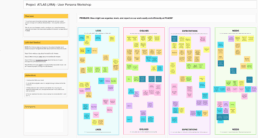PCAOB was struggling with an ineffective project management system. VersionOne, our existing tool, was causing frustration across teams. Leadership couldn’t track work effectively, and employees were using the system inconsistently, if at all.
One of the user’s comment captured the sentiment perfectly: “I’m just doing it because someone else wants it. It doesn’t help me schedule anything.”
Role : Senior UX Designer
Tools Used : Mural, Mentimeter
Understanding the problem
I started with a comprehensive research approach:
1. Heuristic Evaluation : The team conducted a systematic comparison of VersionOne against potential alternatives using Nielsen-Norman Group’s 10 Usability Heuristics.
2. User Research : I spoke with nearly 30 users across different divisions through: Interactive UX workshops to understand needs and motivations One-on-one interviews to explore how project management tools affected daily work
3. User Categorization : I mapped how different teams were using (or avoiding) the current system to identify patterns.
Key Insights
Four critical issues emerged from our conversations:
- Unclear Value Proposition: Users didn’t see how the tool benefited their work.
- Inconsistent Usage: Different teams and scrum masters were using the tool in wildly different ways, creating confusion.
- Training Gaps: Most employees weren’t aware of features that could actually help them.
- Process-Tool Misalignment: As one user put it, “We pick a tool and try to change processes to meet the tool, and sometimes it causes a problem.”
Finding the Solution
The heuristic evaluation revealed that Jira scored higher than VersionOne on 9 out of 10 usability heuristics. But I knew that simply switching tools wouldn’t solve our problems.
The Strategy
Based on my research, I developed a three-part strategy for successful implementation:
1. Personalized Experiences
- Team-specific approaches for work tracking and logging
- Custom dashboards based on different user needs
- Improved work visibility with contextual views
2. Strategic Communication
- Clear messaging about transition benefits
- Regular updates and knowledge-sharing sessions
3. Targeted Training
- Role-specific quick reference guides
- Hands-on scenario practice in sandbox environments
Implementation
Working closely with the PM team, we:
- Classified teams as either Scrum or Kanban based on their work environments
- Prepared custom training for each team based on their specific workflows
- Established weekly support sessions to answer questions after launch
This UX-led research fundamentally changed the organization’s approach to project management:
- 85% adoption rate within the first three months (compared to 40% with previous system)
- 30% reduction in support tickets related to project management confusion
- 90% of leadership reported improved visibility into project status and timelines
The senior leadership team was so impressed by the approach that they established it as a case study for how proper UX research can influence project success. It’s now used as a model for other technology initiatives across the organization.

